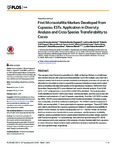Please use this identifier to cite or link to this item:
http://www.alice.cnptia.embrapa.br/alice/handle/doc/1042190Full metadata record
| DC Field | Value | Language |
|---|---|---|
| dc.contributor.author | SANTOS, L. F. dos | pt_BR |
| dc.contributor.author | FREGAPANI, R. M. | pt_BR |
| dc.contributor.author | FALCAO, L. L. | pt_BR |
| dc.contributor.author | TOGAWA, R. C. | pt_BR |
| dc.contributor.author | COSTA, M. M. do C. | pt_BR |
| dc.contributor.author | LOPES, U. V. | pt_BR |
| dc.contributor.author | GRAMACHO, K. P. | pt_BR |
| dc.contributor.author | ALVES, R. M. | pt_BR |
| dc.contributor.author | MICHELI, F. | pt_BR |
| dc.contributor.author | MARCELLINO, L. H. | pt_BR |
| dc.date.accessioned | 2016-03-30T11:11:11Z | pt_BR |
| dc.date.available | 2016-03-30T11:11:11Z | pt_BR |
| dc.date.created | 2016-03-30 | pt_BR |
| dc.date.issued | 2016 | pt_BR |
| dc.identifier.citation | PLoS ONE, v. 11, n. 3, e0151074, 2016. | pt_BR |
| dc.identifier.uri | http://www.alice.cnptia.embrapa.br/alice/handle/doc/1042190 | pt_BR |
| dc.description | The cupuassu tree (Theobroma grandiflorum) (Willd. ex Spreng.) Schum. is a fruitful species from the Amazon with great economical potential, due to the multiple uses of its fruit´s pulp and seeds in the food and cosmetic industries, including the production of cupulate, an alternative to chocolate. In order to support the cupuassu breeding program and to select plants presenting both pulp/seed quality and fungal disease resistance, SSRs from Next Generation Sequencing ESTs were obtained and used in diversity analysis. From 8,330 ESTs, 1,517 contained one or more SSRs (1,899 SSRs identified). The most abundant motifs identified in the EST-SSRs were hepta- and trinucleotides, and they were found with a minimum and maximum of 2 and 19 repeats, respectively. From the 1,517 ESTs containing SSRs, 70 ESTs were selected based on their functional annotation, focusing on pulp and seed quality, as well as resistance to pathogens. The 70 ESTs selected contained 77 SSRs, and among which, 11 were polymorphic in cupuassu genotypes. These EST-SSRs were able to discriminate the cupuassu genotype in relation to resistance/susceptibility to witches? broom disease, as well as to pulp quality (SST/ATT values). Finally, we showed that these markers were transferable to cacao genotypes, and that genome availability might be used as a predictive tool for polymorphism detection and primer design useful for both Theobroma species. To our knowledge, this is the first report involving EST-SSRs from cupuassu and is also a pioneer in the analysis of marker transferability from cupuassu to cacao. Moreover, these markers might contribute to develop or saturate the cupuassu and cacao genetic maps, respectively. | pt_BR |
| dc.language.iso | eng | eng |
| dc.rights | openAccess | eng |
| dc.subject | Melhoramento genético | pt_BR |
| dc.title | First microsatellite markers developed from cupuassu ESTs: application in diversity analysis and cross-species transferability to cacao. | pt_BR |
| dc.type | Artigo de periódico | pt_BR |
| dc.date.updated | 2016-05-31T11:11:11Z | pt_BR |
| dc.subject.thesagro | Cacau | pt_BR |
| dc.subject.thesagro | Cupuaçu | pt_BR |
| dc.subject.thesagro | Fruta Tropical | pt_BR |
| riaa.ainfo.id | 1042190 | pt_BR |
| riaa.ainfo.lastupdate | 2016-05-31 | pt_BR |
| dc.identifier.doi | 10.1371/journal.pone.0151074 | pt_BR |
| dc.contributor.institution | Lucas Ferraz dos Santos, UESC/CENARGEN; Roberta Moreira Fregapani, CENARGEN; LOENI LUDKE FALCAO, CENARGEN; ROBERTO COITI TOGAWA, CENARGEN; MARCOS MOTA DO CARMO COSTA, CENARGEN; Uilson Vanderlei Lopes, CEPLAC/CEPEC; Karina Peres Gramacho, CEPLAC/CEPEC; RAFAEL MOYSES ALVES, CPATU; Fabienne Micheli, UESC/CIRAD; LUCILIA HELENA MARCELLINO, CENARGEN. | pt_BR |
| Appears in Collections: | Artigo em periódico indexado (CPATU)  | |
Files in This Item:
| File | Description | Size | Format | |
|---|---|---|---|---|
| 2016Santos.pdf | 2,2 MB | Adobe PDF |  View/Open |









